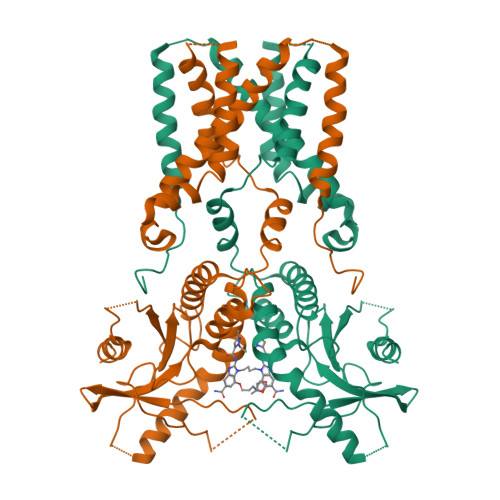Structural insights into a shared mechanism of human STING activation by a potent agonist and an autoimmune disease-associated mutation.
Xie, Z., Wang, Z., Fan, F., Zhou, J., Hu, Z., Wang, Q., Wang, X., Zeng, Q., Zhang, Y., Qiu, J., Zhou, X., Xu, H., Bai, H., Zhan, Z., Ding, J., Zhang, H., Duan, W., Yu, X., Geng, M.(2022) Cell Discov 8: 133-133
- PubMed: 36513640
- DOI: https://doi.org/10.1038/s41421-022-00481-4
- Primary Citation of Related Structures:
8GSZ, 8GT6 - PubMed Abstract:
Stimulator of interferon gene (STING) is increasingly exploited for the potential in cancer immunotherapy, yet its mechanism of activation remains not fully understood. Herein, we designed a novel STING agonist, designated as HB3089 that exhibits robust and durable anti-tumor activity in tumor models across various cancer types. Cryo-EM analysis reveals that HB3089-bound human STING has structural changes similar to that of the STING mutant V147L, a constitutively activated mutant identified in patients with STING-associated vasculopathy with onset in infancy (SAVI). Both structures highlight the conformational changes of the transmembrane domain (TMD), but without the 180°-rotation of the ligand binding domain (LBD) previously shown to be required for STING activation. Further structure-based functional analysis confirmed a new STING activation mode shared by the agonist and the SAVI-related mutation, in which the connector linking the LBD and the TMD senses the activation signal and controls the conformational changes of the LBD and the TMD for STING activation. Together, our findings lead to a new working model for STING activation and open a new avenue for the rationale design of STING-targeted therapies either for cancer or autoimmune disorders.
Organizational Affiliation:
State Key Laboratory of Drug Research, Shanghai Institute of Materia Medica, Chinese Academy of Sciences, Shanghai, China.



















